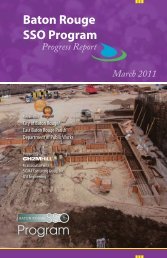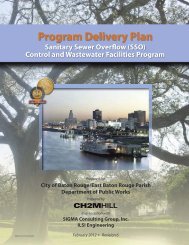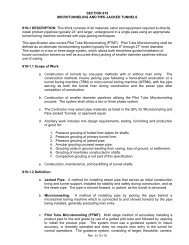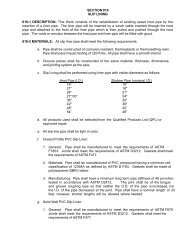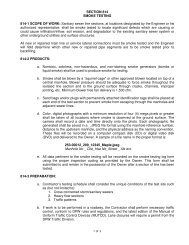Contents
Construction Management Plan - Baton Rouge Department of Public ...
Construction Management Plan - Baton Rouge Department of Public ...
- No tags were found...
You also want an ePaper? Increase the reach of your titles
YUMPU automatically turns print PDFs into web optimized ePapers that Google loves.
• Review and sign Attachment 1 to SOP-121, Respiratory Protection, Information for<br />
Voluntary Use of Respirators (Attachment 5);<br />
• Review the proper use (including using the nose clip), limitations, care and the information<br />
provided with the respirator;<br />
• Verify the respirator is a NIOSH-approved respirator for emergency escape.<br />
• Verify the respirator is for chlorine gas;<br />
• Verify the respirator is in working order, that the end of service life has not expired (some<br />
models have an “End of Service Life” blue dot to indicate if the respirator has not expired);<br />
• Wear goggles, or at least safety glasses with side shields when in areas where chlorine is<br />
stored or used;<br />
• Evacuate the area immediately when the first alarm sounds, or when told to do so by plant<br />
personnel or others if there is no alarm;<br />
• Proceed directly to the nearest designated assembly area for a head count, moving<br />
perpendicular to the wind direction;<br />
• Contact the PM and RHSM if escape respirators are planned to be used.<br />
2.2.4 Compressed Gas Cylinders<br />
• Valve caps must be in place when cylinders are transported, moved, or stored.<br />
• Cylinder valves must be closed when cylinders are not being used and when cylinders are<br />
being moved.<br />
• Cylinders must be secured in an upright position at all times.<br />
• Cylinders must be shielded from welding and cutting operations and positioned to avoid being<br />
struck or knock over; contacting electrical circuits; or exposed to extreme heat sources.<br />
• Cylinders must be secured on a cradle, basket, or pallet when hoisted; they may not be hoisted<br />
by choker slings.<br />
2.2.5 Concrete and Masonry Construction<br />
(Reference CH2M HILL SOP HSE&Q-302, Concrete and Masonry)<br />
• Wear appropriate personal protective equipment (eye/face protection, gloves, rubber boots)<br />
when in areas where concrete is being poured.<br />
• Protruding reinforcing steel (rebar), onto which personnel could fall, must be guarded to<br />
eliminate the hazard of impalement.<br />
• Stay as clear as possible of all hoisting operations. Loads, including concrete buckets, shall not<br />
be hoisted overhead of personnel.<br />
• Maintain a safe distance from formwork and shoring being removed from concrete structures.<br />
• Maintain a safe distance from precast and lift-slab concrete being lifted into position until<br />
physically secured.<br />
• Do not stand behind the tensioning jacks during post-tensioning.<br />
• Do not ride concrete buckets.<br />
• Do not enter limited access zones during concrete or masonry wall construction.<br />
A-14 GNV310133632156.DOC/090840008



